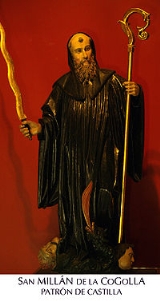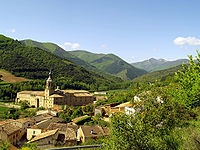
Emilianus
Encyclopedia

Saint Aemilian is an Iberic
Iberian Peninsula
The Iberian Peninsula , sometimes called Iberia, is located in the extreme southwest of Europe and includes the modern-day sovereign states of Spain, Portugal and Andorra, as well as the British Overseas Territory of Gibraltar...
saint, widely revered throughout Spain
Spain
Spain , officially the Kingdom of Spain languages]] under the European Charter for Regional or Minority Languages. In each of these, Spain's official name is as follows:;;;;;;), is a country and member state of the European Union located in southwestern Europe on the Iberian Peninsula...
, who lived during the age of Visigothic rule
Visigothic Kingdom
The Visigothic Kingdom was a kingdom which occupied southwestern France and the Iberian Peninsula from the 5th to 8th century AD. One of the Germanic successor states to the Western Roman Empire, it was originally created by the settlement of the Visigoths under King Wallia in the province of...
.
Life
Much controversy surrounded his place of birth, described as Vergegio in his VitaHagiography
Hagiography is the study of saints.From the Greek and , it refers literally to writings on the subject of such holy people, and specifically to the biographies of saints and ecclesiastical leaders. The term hagiology, the study of hagiography, is also current in English, though less common...
: the most current is Berceo
Berceo
Berceo is a municipality in La Rioja, Spain. It is located near the monastery of San Millán de la Cogolla and was the birthplace of Gonzalo de Berceo. It has also been proposed as identification of historic Vergegio, named by Braulio of Zaragoza as the birth place of Saint Millán, although...
in La Rioja, close to the monastery
Monastery
Monastery denotes the building, or complex of buildings, that houses a room reserved for prayer as well as the domestic quarters and workplace of monastics, whether monks or nuns, and whether living in community or alone .Monasteries may vary greatly in size – a small dwelling accommodating only...
that bears his name and conserves his relics. In the past, Aragon also claimed to have been the origin of the saint.
According to his Vita, written by Braulius, bishop of Caesaraugusta (modern Zaragoza) roughly a hundred years after Aemilian's death, the saint was a shepherd until a sudden conversion, perhaps around the age of twenty, decided him upon the hermitical life. He sought out a more experienced hermit in Bilibio, Felix
San Felices
San Felices is a municipality located in the province of Soria, Castile and León, Spain. According to the 2004 census , the municipality has a population of 81 inhabitants....
(although known more usually by the Spanish form of his name, San Felices), where he lived for a number of years. He then left his master, and lived as a hermit (perhaps even a gyrovagus) in the mountains, whence he was summoned and ordained as priest in Berceo
Berceo
Berceo is a municipality in La Rioja, Spain. It is located near the monastery of San Millán de la Cogolla and was the birthplace of Gonzalo de Berceo. It has also been proposed as identification of historic Vergegio, named by Braulio of Zaragoza as the birth place of Saint Millán, although...
by Didymus the Bishop of Tarazona
Diocese of Tarazona
The Diocese of Tarazona is a Roman Catholic bishopric located in north-eastern Spain, in the provinces of Zaragoza, Soria, Navarre and...
.
In order to escape the duties of the clerical life, he distributed the monies of the church to the poor to such an extent that he aroused the opposition of his fellow priests and was allowed to return to the wilderness.
There he lived attracting a large following amongst the laity and a small community of disciples around his cell. He died at a venerable age, and was buried in his cell. Some few miracles are recorded by Braulius as having occurred after Aemilian's death.
Veneration
The mountain hermitage he occupied in La Rioja became the site of the Mozarabic monastery of San Millán de Suso, which then co-existed for a time in the eleventh century with San Millán de Yuso (the 'upper' and 'lower' monasteries respectively), until Suso ceased to function with a separate abbotAbbot
The word abbot, meaning father, is a title given to the head of a monastery in various traditions, including Christianity. The office may also be given as an honorary title to a clergyman who is not actually the head of a monastery...
in the early twelfth century.
Both monasteries are known as San Millán de la Cogolla.
He is a patron saint of Castile
Castile (historical region)
A former kingdom, Castile gradually merged with its neighbours to become the Crown of Castile and later the Kingdom of Spain when united with the Crown of Aragon and the Kingdom of Navarre...
, where he is known as San Millán de la Cogolla, the "cowl
Cowl
This article is about the garment used by monks and nuns. For other uses, see Cowl or Cowling .The cowl is an item of clothing consisting of a long, hooded garment with wide sleeves. Originally it may have referred simply to the hooded portion of a cloak...
ed" Saint Emilian.
Emilianus is represented as a monk on horseback fighting the Moors
Moors
The description Moors has referred to several historic and modern populations of the Maghreb region who are predominately of Berber and Arab descent. They came to conquer and rule the Iberian Peninsula for nearly 800 years. At that time they were Muslim, although earlier the people had followed...
, similar to the representation of Saint James the Moor-slayer, and sometimes as a Benedictine
Benedictine
Benedictine refers to the spirituality and consecrated life in accordance with the Rule of St Benedict, written by Benedict of Nursia in the sixth century for the cenobitic communities he founded in central Italy. The most notable of these is Monte Cassino, the first monastery founded by Benedict...
on horseback with a banner and sword.
Gonzalo de Berceo
Gonzalo de Berceo
Gonzalo de Berceo was a Spanish poet born in the Riojan village of Berceo, close to the major Benedictine monastery of San Millán de la Cogolla...
wrote an account of his life called the Vida de San Millán de la Cogolla.
See also
- San Millán de la Cogolla, La RiojaSan Millán de la Cogolla, La RiojaSan Millán de la Cogolla is a sparsely populated municipality in La Rioja, . It takes its name from a 6th-century saint who lived here, and from the shape of the surrounding mountains . The village is famous for its twin monasteries, Yuso and Suso, which were declared a World Heritage Site in 1997...
- :es:Monasterio de San Millán de Yuso
- :es:Monasterio de San Millán de Suso

